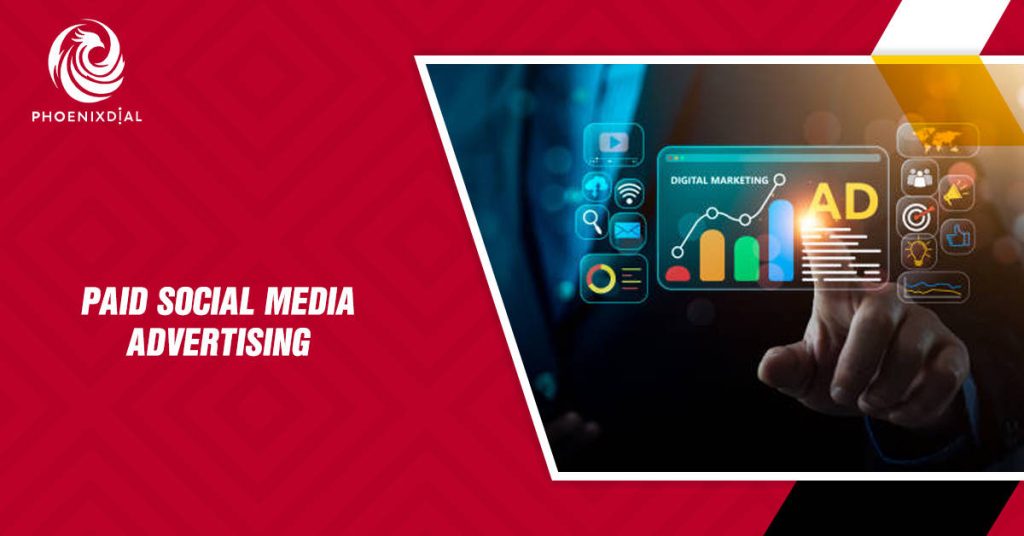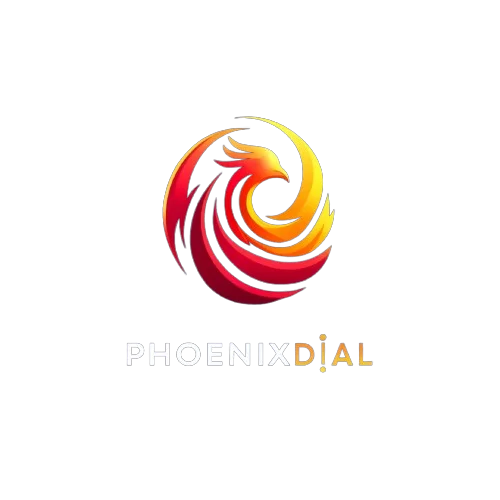
Paid Social Media Advertising | Business Growth Strategies

Did you know that over 70% of businesses now rely on paid social media advertising to reach their audience faster and drive consistent results? Social media platforms have become more competitive, and organic posts often struggle to get the visibility they deserve.
Many small businesses work hard to create great content but still fail to gain attention. The truth is, organic reach on most platforms is shrinking. Without a strong paid social advertising strategy, it becomes difficult to attract new customers or maintain visibility.
At Phoenix Dial, our experienced digital marketing team knows how to turn this challenge into an opportunity. We create paid social media campaigns that target your ideal audience, boost engagement, and bring measurable growth.
Table of Contents
ToggleIn this post, we’ll explore what paid social media advertising is, why it’s essential for your business, and how you can build a smart strategy to get the most out of your ad spend. By the end, you’ll know how to reach the right audience, increase visibility, and use paid social media to grow your business effectively.
Start Growing Your Business Today
Get a free, personalized quote via WhatsApp for your business. No pressure—just smart solutions tailored to your goals.
What Is Paid Social Media Advertising?
Paid social media advertising means paying to show your posts, products, or services to more people on social media platforms. Instead of waiting for users to find you, you promote your content directly to a selected audience. It’s one of the most effective ways to reach new customers and grow faster online.
Businesses use paid ads on social media to connect with people who are most likely to be interested in their products or services. For example, a clothing store can run paid social media campaigns on Instagram to show new arrivals to users who follow fashion pages. A tech company can promote its products on LinkedIn to reach professionals in its field.
With paid social media marketing, you can choose who sees your ads based on age, location, interests, and behavior. This makes advertising more focused and effective. Instead of reaching everyone, you reach only the right people — saving time, effort, and money while growing your brand faster.
Benefits of Paid Social Media Advertising
Paid social media advertising gives businesses the power to grow faster and reach more people than organic posts ever could. It helps brands connect with the right audience, build awareness, and turn followers into real customers. Whether you’re running a small business or managing a growing brand, using paid social advertising offers many advantages that can boost your online success.
Reach Target Audience Easily
One of the biggest benefits of paid social media marketing is that it lets you choose exactly who sees your ads. You can target people by age, location, interests, or behavior. For example, if you sell handmade candles, you can reach people who already follow home décor or lifestyle pages. This kind of focused targeting makes advertising on social media platforms more effective and saves you from wasting money on uninterested audiences.
Faster Results
Unlike organic posts, which take time to grow, paid ads on social media deliver quick visibility. As soon as your ad goes live, it starts appearing in front of your target audience. Businesses can use this to promote limited-time offers, new launches, or special events. It’s one of the fastest ways to build brand awareness and attract attention.
Boost Engagement
Paid social media campaigns help you get more likes, comments, and shares by showing your content to the right people. When users see posts that match their interests, they’re more likely to engage. This not only increases your brand’s reach but also helps build stronger relationships with your audience.
Increase Sales and Leads
With paid social acquisition, you can drive more traffic to your website and turn visitors into customers. Paid ads allow you to promote products, collect sign-ups, or encourage direct purchases. Many small businesses have doubled their sales simply by using smart paid advertising strategies that guide people from seeing an ad to taking action.
Better Data and Tracking
One of the best parts of developing a paid advertising strategy is access to detailed insights. You can see who clicked, what they liked, and which ads worked best. These reports help you understand your audience better and improve future campaigns. Over time, this data-driven approach makes your paid social best practices stronger and your marketing more successful.
Popular Paid Social Media Platforms for Running Ads in 2025
In 2025, advertising on social media platforms continues to be one of the most effective ways to promote products and services. Different platforms offer unique features, audiences, and ad formats that help businesses grow. Choosing the right platform depends on who you want to reach and what type of content connects best with them. Let’s explore some of the most popular options for paid ads on social media this year.
Facebook Ads
Facebook remains one of the strongest platforms for paid social campaigns. It allows advertisers to target users based on interests, age, gender, and even behavior. Businesses can run photo ads, video ads, or carousel ads to promote their brand. For example, a local restaurant can run ads to reach people living nearby who love dining out.
Instagram Ads
Instagram is perfect for brands that rely on visuals. Through stories, reels, and post ads, companies can attract users with creative images or short videos. It’s ideal for lifestyle, beauty, fashion, and food brands looking to increase engagement. With its connection to Facebook’s ad system, you can easily run campaigns across both platforms together.
TikTok Ads
TikTok has become a favorite for reaching younger audiences. Its short-form videos make advertising fun, creative, and attention-grabbing. Businesses can create challenges, product demos, or influencer partnerships to promote their offers. It’s one of the best platforms for brands that want to stay trendy and relatable.
LinkedIn Ads
LinkedIn is the go-to platform for professionals and B2B marketing. It works well for service-based companies, tech firms, and educational programs. You can target users by job title, company size, or industry. A digital agency, for example, can use LinkedIn to reach decision-makers looking for paid social media services or marketing support.
YouTube Ads
YouTube is all about video storytelling. Businesses can run skippable or non-skippable video ads before or during videos. It’s an excellent way to show how a product works or share customer stories. Many brands use YouTube ads as part of their paid advertising strategies to boost awareness and trust.
Pinterest Ads
Pinterest is great for brands with visually appealing products like fashion, décor, or crafts. Ads appear in users’ feeds as promoted pins, blending naturally with organic content. This makes it easy for users to discover and save products they love. It’s a strong platform for driving website traffic and inspiring purchase ideas.
How Paid Social Media Advertising Works
Paid social media advertising works by helping businesses show their content to the right people at the right time. It’s a step-by-step process where advertisers decide how much they want to spend, who they want to reach, and what type of ad to run. This allows businesses to control every part of their campaign and measure how well it performs.
First, advertisers set a budget — this is the amount of money they are willing to spend on ads. You can start small and increase your spending as you see good results. Next, they choose a target audience based on details like age, location, interests, and behavior. This ensures the ad is seen by people who are most likely to be interested in the product or service.
After setting the audience, advertisers select an ad type — such as image, video, story, or carousel ads — depending on what fits their goals best. For example, a bakery may choose video ads to show how its cakes are made, while a clothing store might use image ads to display new arrivals.
The concept of bidding and impressions is simple. Every time an ad is shown to someone, it counts as an impression. Advertisers “bid” for these spots, meaning they compete with others who want their ads to appear in the same space. The platform then shows the ad that best matches the audience and budget. This system helps ensure that your advertising on social media reaches the right people efficiently while keeping costs under control.
Build a Paid Social Media Strategy
Building a smart paid social media strategy helps you make the most of your time and budget. It’s not just about running ads — it’s about knowing your goals, understanding your audience, and improving with every campaign. A clear plan ensures your paid social media marketing efforts bring real results instead of random clicks. Here’s how you can do it step-by-step.
Step 1: Define Your Goal
Every strong strategy starts with a clear goal. Ask yourself what you want to achieve — more website visits, higher sales, brand awareness, or app downloads. When you set a specific goal, it becomes easier to measure success and adjust your paid social campaigns to match your needs.
Step 2: Know Your Audience
Your ads only work if they reach the right people. Learn who your ideal customers are — their age, location, interests, and habits. For example, if you sell fitness gear, target users who follow workout pages or health tips. Knowing your audience helps you focus your advertising on social media where it truly matters.
Step 3: Pick the Right Platform
Not all platforms deliver the same results. Choose the one that best fits your business and audience. Facebook and Instagram are great for visuals and wide reach, while LinkedIn works better for professionals and B2B services. This step ensures your developing a paid advertising strategy is focused and effective.
Step 4: Create Engaging Ads
Your ad should grab attention instantly. Use bright images, short videos, and clear messages that tell people what to do next. A strong call-to-action like “Shop Now” or “Learn More” can make a big difference. Creative and relatable content always performs better in paid social advertising.
Step 5: Set Budget and Schedule
Decide how much you want to spend and how long your ads will run. You can start small and adjust your spending based on performance. Many platforms let you set a daily or total campaign budget, giving you full control over costs. A balanced budget helps you manage your paid social acquisition wisely.
Step 6: Track and Improve
Once your ads are live, check how they perform using built-in analytics tools. Look at results like clicks, impressions, and conversions. If an ad isn’t performing well, make small changes to improve it. This data-driven approach helps you build paid social best practices and create stronger campaigns over time.
Common Mistakes to Avoid
Running paid social advertising can bring great results, but small mistakes can easily reduce its impact. Many businesses waste money or miss chances because they overlook simple details. Knowing what to avoid helps you build stronger, more effective campaigns. Here are a few common errors to watch out for when running paid ads on social media.
Targeting too broad an audience
Trying to reach everyone often means reaching no one. When your audience is too wide, your message becomes less relevant, and your budget spreads thin. Focus on specific groups based on interests, age, or behavior. For example, if you sell beauty products, target people who follow skincare or makeup pages rather than everyone online. This improves your paid social media campaigns and saves money.
Ignoring ad testing or analytics
Skipping testing is like guessing what works. Use A/B testing to try different headlines, images, or ad formats. Platforms also provide detailed analytics to track performance. These insights help you adjust your paid advertising strategies and see what truly connects with your audience.
Using poor-quality visuals or unclear messages
Low-quality images or confusing text can make people scroll past your ad. Clear visuals and short, simple messages grab attention faster. Always use sharp images, readable fonts, and consistent branding to make your advertising on social media look professional and trustworthy.
Forgetting to include a call-to-action (CTA)
Every ad needs a purpose. Without a strong CTA like “Buy Now” or “Sign Up Today,” users won’t know what to do next. A clear CTA guides your audience toward action and increases conversions. Adding this small detail can make a big difference in the success of your paid social media marketing efforts.
Conclusion
Paid social media advertising has become one of the most powerful ways to grow a business online. It helps brands reach the right people, increase visibility, and boost engagement faster than organic posts. When used with the right strategy, it can turn simple ads into real opportunities for growth.
To get the best results, focus on understanding your audience, setting clear goals, and tracking every campaign. Avoid common mistakes and keep improving your paid social media campaigns over time.
If you want expert help building or managing your paid social media marketing strategy, our team at Phoenix Dial is ready to help. We create smart, data-driven campaigns that deliver real results and help your business stand out. Visit Phoenix Dial today to start your journey toward better visibility and higher conversions.
FAQs
How much does a paid social media ad cost?
The cost of paid social media advertising depends on the platform, audience, and goal. On average, businesses spend anywhere from $0.50 to $3 per click or $5 to $10 per 1,000 impressions.
Is it worth paying for social media ads?
Yes, it’s worth it. Paid social advertising helps you reach a specific audience quickly, boost engagement, and increase sales — making it one of the most effective digital marketing tools.
What is the 50 30 20 rule in social media marketing?
This rule suggests sharing 50% engaging content, 30% promotional content, and 20% curated or shared posts from others. It helps keep your social media feed balanced and interesting.
What is an example of a paid social media ad?
An example is a Facebook ad promoting a new product, an Instagram story ad offering a discount, or a YouTube video ad showing a brand story. These are all forms of paid social media campaigns designed to attract and convert users.




